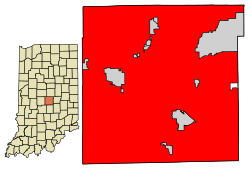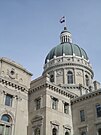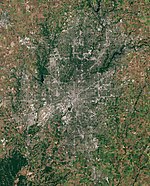Indianapolis
Indianapolis | |
|---|---|
| City of Indianapolis and Marion County | |
| Nickname(s): "Indy", "Circle City", "Crossroads of America", "Naptown", "Racing Capital of the World", "Amateur Sports Capital of the World", "Railroad City"[1] | |
 Location within Marion County | |
| Coordinates: 39°46′07″N 86°09′29″W / 39.76861°N 86.15806°W | |
| Country | United States |
| State | Indiana |
| County | Marion |
| Townships | Center, Decatur, Franklin, Lawrence, Perry, Pike, Warren, Washington, Wayne |
| Founded | January 6, 1821[2] |
| Incorporated (town) | September 3, 1831[2] |
| Incorporated (city) | March 30, 1847[2] |
| City-county consolidation | January 1, 1970[3] |
| Government | |
| • Type | Strong mayor–council |
| • Body | Indianapolis City-County Council |
| • Mayor | Joe Hogsett (D) |
| Area | |
| • State capital and consolidated city-county | 367.93 sq mi (952.95 km2) |
| • Land | 361.64 sq mi (936.64 km2) |
| • Water | 6.29 sq mi (16.30 km2) |
| Elevation | 718 ft (219 m) |
| Population (2020) | |
| • State capital and consolidated city-county | 887,642 |
| • Rank | 16th in the United States 1st in Indiana |
| • Density | 2,454.50/sq mi (947.69/km2) |
| • Urban | 1,699,881 (US: 32nd) |
| • Urban density | 2,352.6/sq mi (908.4/km2) |
| • Metro | 2,111,040 (US: 33rd) |
| Demonym | Indianapolitan[7] |
| Time zone | UTC−5 (EST) |
| • Summer (DST) | UTC−4 (EDT) |
| ZIP Codes | 61 total ZIP codes:
|
| Area codes | 317 and 463 |
| FIPS code | 18-36003[8] |
| GNIS feature ID | 2395423[5] |
| Website | www |
Indianapolis (/ˌɪndiəˈnæpəlɪs/ IN-dee-ə-NAP-əl-iss),[9][10] commonly called Indy, is the capital and most populous city of the U.S. state of Indiana. It is also the seat of Marion County and is combined with the county as a part of Unigov. The U.S. Census Bureau said that the population of Indianapolis together with Marion County was 977,203 in 2020.[11] The "balance" population was 887,642.[12] This measurement leaves out some cities that are slightly autonomous from Unigov. It is the 16th-most populous city in the U.S., the third-most populous city in the Midwest after Chicago and Columbus, Ohio, and the fourth-most populous state capital after Phoenix, Arizona, Austin, Texas, and Columbus. The Indianapolis metropolitan area is the 33rd-most populous metropolitan statistical area in the U.S., with 2,111,040 residents.[13] Its combined statistical area ranks 28th, with a population of 2,431,361.[14] Indianapolis has an area of 368 square miles (950 km2). This makes it the 18th largest city by land area in the U.S.
Indigenous peoples lived in the area as early as 10,000 BC.[15] In 1818, the Lenape gave their territory to the U.S. in the Treaty of St. Mary's.[16] In 1821, Indianapolis was made as a planned city to be the new capital of Indiana. The old capital was Corydon. The city was platted by Alexander Ralston and Elias Pym Fordham on a 1-square-mile (2.6 km2) grid next to the White River. The finishing of the National and Michigan roads and the start of railroad building made the city an important transport hub.[17] Two of the nicknames for Indianapolis (the "Crossroads of America" and "Railroad City") matches the city's history with transportation.[18][19][1] In 1970, Indianapolis and Marion County were combined. This system is called Unigov. The city is led by an elected 25-member city-county council led by the mayor.
Indianapolis has the 30th-largest city economy in the U.S. It is based on the industries of trade, transportation, utilities, business services, education, health, government, leisure, and manufacturing.[20] The city has big amateur sports and auto racing markets.[21][22] The city is home to three Fortune 500 companies, two major league sports teams, the Indianapolis Colts of the National Football League and the Indiana Pacers of the National Basketball Association, five university campuses, and many museums.[23] Indianapolis has the world's largest children's museum.[24] The city is maybe best known for hosting the world's largest single-day sporting event, the Indianapolis 500.[25][26] The city has many historic sites and districts. Indianapolis has the most monuments about veterans and war casualties in the U.S. outside of Washington, D.C.[27][28]
References
[change | change source]- ↑ 1.0 1.1 Bodenhamer, David J.; Barrows, Robert G., eds. (1994). The Encyclopedia of Indianapolis. Bloomington and Indianapolis: Indiana University Press. pp. 1266–1267. ISBN 0-253-31222-1.
- ↑ 2.0 2.1 2.2 Bodenhamer, David; Barrows, Robert, eds. (1994). The Encyclopedia of Indianapolis. Bloomington & Indianapolis: Indiana University Press. pp. 1479–80.
- ↑ "Unigov Handbook: A Citizen's Guide to Local Government" (PDF). League of Women Voters of Indianapolis. Archived from the original (PDF) on March 13, 2017. Retrieved March 12, 2017.
- ↑ "2020 U.S. Gazetteer Files". United States Census Bureau. Retrieved March 16, 2022.
- ↑ 5.0 5.1 "Indianapolis". Geographic Names Information System. United States Geological Survey. Retrieved April 10, 2021.
- ↑ "2020 Population and Housing State Data". United States Census Bureau. Retrieved 22 August 2021.
- ↑ "Definition of Indianapolitan". Merriam-Webster Dictionary. Retrieved August 1, 2016.
- ↑ "U.S. Census website". United States Census Bureau. Retrieved January 31, 2008.
- ↑ Jones, Daniel (2003) [1917]. Peter Roach; James Hartmann; Jane Setter (eds.). English Pronouncing Dictionary. Cambridge: Cambridge University Press. ISBN 3-12-539683-2.
- ↑ "Indianapolis". Merriam-Webster Dictionary.; "Indianapolis". Dictionary.com Unabridged. Random House.
- ↑ "QuickFacts: Marion County, Indiana". United States Census Bureau. Retrieved 20 August 2021.
- ↑ "QuickFacts: Indianapolis city (balance), Indiana". United States Census Bureau. Retrieved 20 August 2021.
- ↑ "Cumulative Estimates of Resident Population Change and Rankings: April 1, 2010 to July 1, 2018 – United States – Metropolitan Statistical Area; and for Puerto Rico 2018 Population Estimates". U.S. Census Bureau. July 2019. Retrieved November 13, 2019.
- ↑ "U.S. Census website". U.S. Census Bureau. July 2019. Retrieved November 13, 2019.
- ↑ James R. Jones III, PhD.; Amy L. Johnson (2016). "Early Peoples of Indiana" (PDF). Indiana Department of Natural Resources Division of Historic Preservation and Archaeology. Archived from the original (PDF) on July 25, 2020. Retrieved August 11, 2020.
- ↑ Bodenhamer, David; Robert Graham Barrows; David Gordon Vanderstel (1994). The Encyclopedia of Indianapolis. Indiana University Press. ISBN 0-253-31222-1. p. 1042
- ↑ Bodenhamer, David; Barrows, Robert, eds. (1994). The Encyclopedia of Indianapolis. Bloomington & Indianapolis: Indiana University Press. p. 190.
- ↑ "Metro Indianapolis Export Plan" (PDF). Indy Chamber. Archived from the original (PDF) on October 22, 2016. Retrieved August 16, 2016.
- ↑ "Capital at the Crossroads of America–Indianapolis: A Discover Our Shared Heritage Travel Itinerary". National Park Service (U.S. Dept. of the Interior). Retrieved March 24, 2016.
- ↑ "Indianapolis Area Economic Summary" (PDF). U.S. Department of Labor Bureau of Labor Statistics. February 3, 2022. Retrieved February 15, 2022.
- ↑ Rick Mattoon; Norman Wang (2014). "Industry clusters and economic development in the Seventh District's largest cities" (PDF). Economic Perspectives. pp. 56–58. Archived from the original (PDF) on October 22, 2016. Retrieved August 16, 2016.
- ↑ Ted Greene and Jon Sweeney (January 20, 2012). Naptown to Super City (television broadcast). WFYI. Archived from the original on December 18, 2017. Retrieved May 26, 2023.
- ↑ Clark, Andrew (May 21, 2018). "Fortune 500 list: Indiana RV manufacturer makes it for the first time". The Indianapolis Star. Retrieved August 2, 2019.
- ↑ Quinn, Samm (January 2, 2020). "Children's museum reports record attendance in 2019". Indianapolis Business Journal. Retrieved August 12, 2020.
- ↑ Keefer, Zak (April 30, 2016). "How the Indianapolis 500 became more than a race". The Indianapolis Star. Gannett Co. Retrieved May 29, 2022.
- ↑ Davidson, Donald (2021) [1994]. "Indianapolis 500-Mile Race". Digital Encyclopedia of Indianapolis. Indianapolis Public Library. Retrieved May 29, 2022.
- ↑ Mitchell, Dawn (May 25, 2015). "Monumental Indianapolis: Touring Indianapolis memorials". The Indianapolis Star. Retrieved March 25, 2016.
- ↑ "Message from the Executive Director". Indiana War Memorial. Retrieved March 25, 2016.













